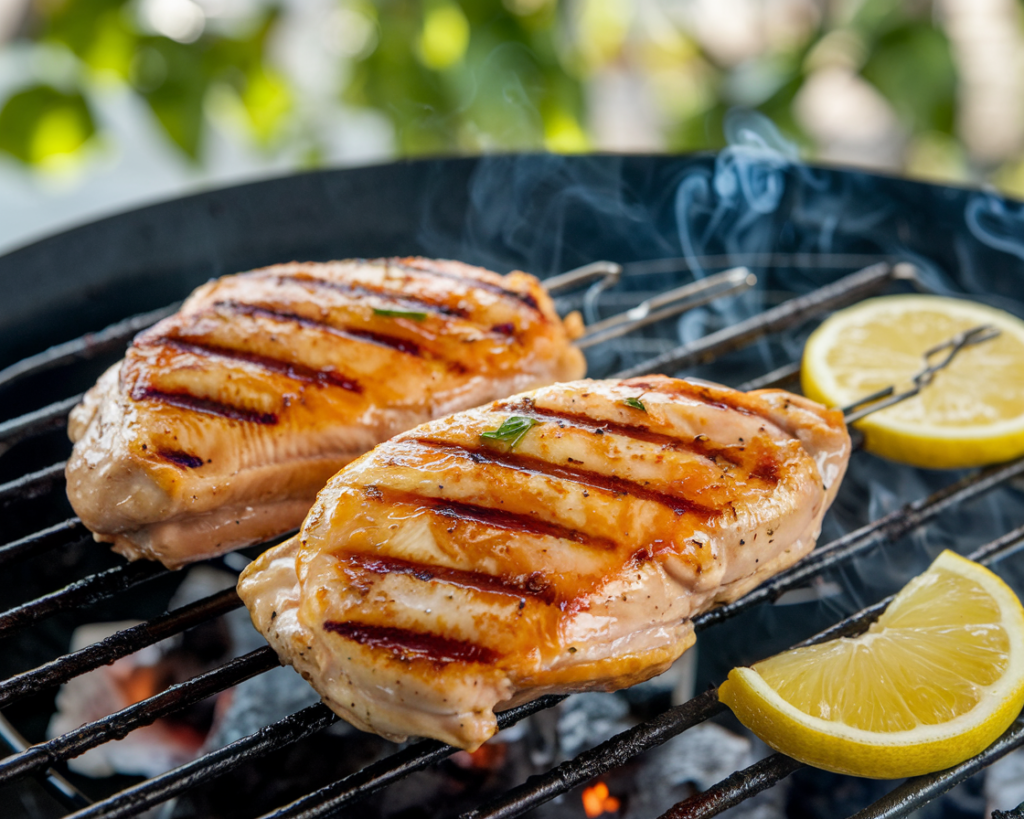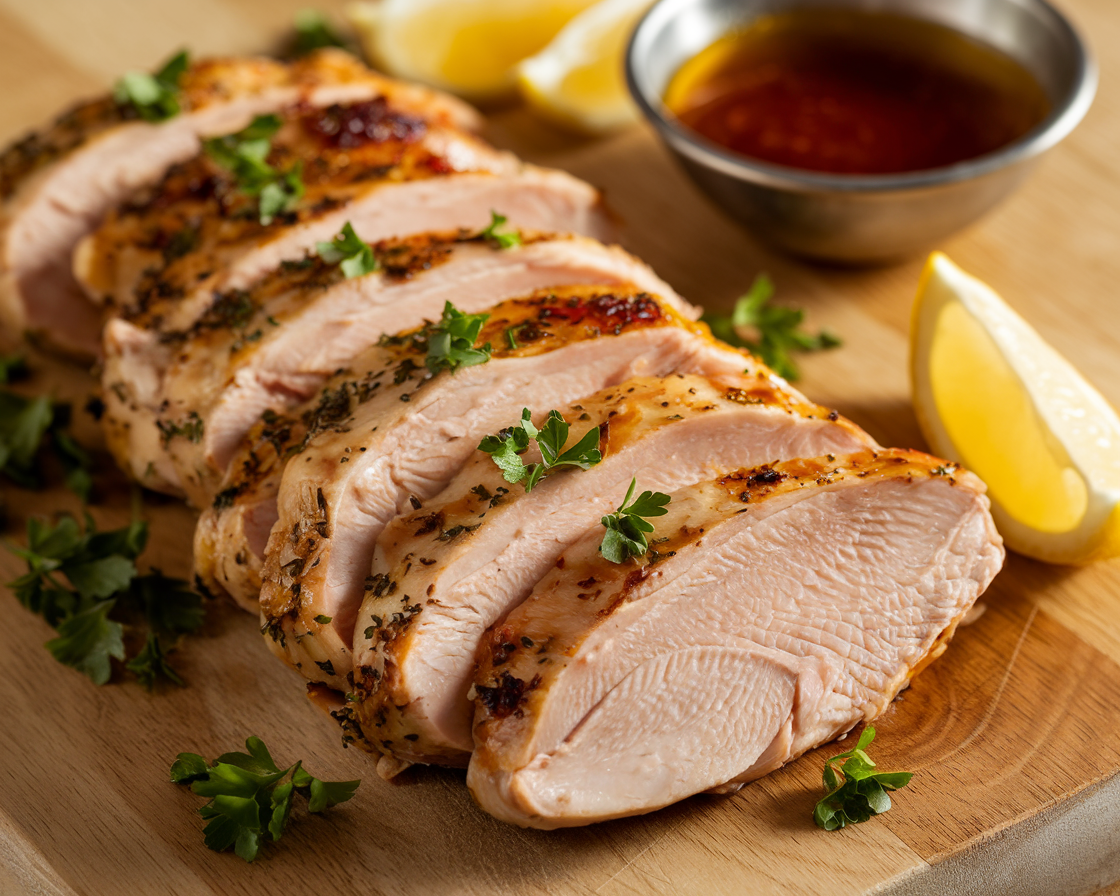If you’ve ever struggled with dry, bland chicken breast, you’re not alone. It’s one of the most common cooking challenges, but the good news is that it’s entirely avoidable. With the right preparation, techniques, and a little patience, you can ensure every chicken breast you cook is tender, flavorful, and—most importantly—juicy. In this guide, we’ll break down everything you need to know to master juicy chicken breast every time.
Understanding the Importance of Juicy Chicken Breast
Why Moisture is Key to Perfect Chicken Breast
Moisture is the heart of a perfect chicken breast. Not only does it make the meat tender and flavorful, but it also enhances the overall eating experience. Dry chicken breast can feel like chewing on cardboard, while a juicy one is succulent and satisfying. Achieving that juiciness requires a combination of preparation and precise cooking methods.
“Juicy chicken is like the golden ticket to culinary success—it elevates even the simplest dishes to gourmet levels!”
Common Challenges in Keeping Chicken Breast Juicy
Chicken breast is naturally lean, which means it lacks the fat that keeps other cuts of meat moist during cooking. Overcooking, inadequate preparation, or using the wrong cooking technique are the usual culprits behind dryness. Understanding these challenges is the first step in overcoming them.
Preparing Chicken Breast for Maximum Juiciness
Choosing the Best Quality Chicken
The quality of the chicken you start with plays a big role in the final result. Fresh chicken breast is always the best choice, as frozen options often lose some moisture during the thawing process. Look for plump, even cuts of chicken breast without bruising or discoloration. Organic or free-range chicken typically has better texture and flavor.
| Type of Chicken | Benefits |
|---|---|
| Fresh Chicken | Retains more moisture during cooking |
| Organic Chicken | Richer flavor and better texture |
| Free-Range Chicken | Better quality with fewer additives |
The Role of Brining in Juicy Chicken Breast
Brining is a game-changer when it comes to keeping chicken breast juicy. A simple brine made of water, salt, and sugar helps the meat absorb extra moisture before cooking. For added flavor, consider adding garlic, herbs, or citrus slices to the brine. Let the chicken sit in the brine for at least 2-4 hours or overnight for the best results.
“Brining isn’t just a step—it’s the secret ingredient for next-level juiciness!”
Marinades That Enhance Flavor and Retain Moisture
If you want to infuse flavor while keeping the chicken moist, marinades are your go-to. A marinade with oil, an acid like lemon juice or vinegar, and your favorite seasonings works wonders. The oil locks in moisture, while the acid tenderizes the meat. Let the chicken marinate for at least 2 hours or up to 24 hours for maximum flavor.
| Marinade Ingredients | Quantity |
|---|---|
| Olive Oil | 3 tablespoons |
| Lemon Juice | 2 tablespoons |
| Garlic (minced) | 2 cloves |
| Salt | 1 teaspoon |
| Paprika | 1 teaspoon |
Cooking Techniques That Preserve Juiciness
The Low-and-Slow Cooking Method
One of the most effective ways to ensure juicy chicken breast is to cook it slowly over low heat. Whether you’re baking, grilling, or smoking, maintaining a low temperature allows the chicken to cook evenly without drying out. For baking, set your oven to 325°F and cover the chicken with foil to trap moisture. On the grill, keep the heat on medium-low and flip the chicken frequently to avoid overcooking.
“Cooking chicken breast is like playing a slow song—patience brings out the best rhythm of flavors and textures.”
Using Sous Vide for Perfectly Moist Chicken Breast
Sous vide cooking is a foolproof way to achieve juicy chicken breast. By vacuum-sealing the chicken and cooking it in a water bath at a precise temperature (typically 145°F to 150°F), you lock in moisture and ensure even cooking. After the sous vide process, a quick sear in a hot pan adds a golden crust without losing any of the juices.
Pan-Seared to Perfection: A Quick and Juicy Option
If you’re short on time but still want juicy chicken, pan-searing is an excellent choice. Start by heating a bit of oil in a skillet over medium heat. Sear the chicken breast for 2-3 minutes on each side until golden brown. Lower the heat, add a splash of chicken broth or water, cover the pan, and let it cook for another 5-7 minutes. This steam-trapping technique helps keep the chicken moist.
Temperature and Timing: The Science Behind Juicy Chicken
Ideal Internal Temperature for Chicken Breast
The key to juicy chicken breast lies in reaching the perfect internal temperature of 165°F. Use a meat thermometer to check the thickest part of the chicken breast, ensuring it’s cooked through but not overdone. Avoid cooking beyond this temperature, as every degree above 165°F dries out the meat.
Resting Chicken for Retained Juices
Letting the chicken rest after cooking is a step you should never skip. Resting allows the juices to redistribute throughout the meat, making every bite moist and tender. Cover the chicken loosely with foil and let it rest for 5-10 minutes before slicing or serving.
“Think of resting your chicken as letting it catch its breath—it ensures every bite is packed with flavor and juiciness.”
Avoiding Overcooking: The Key to Tender Meat
Overcooking is the number one reason chicken breast turns dry. To avoid this, stick to recommended cooking times and check the internal temperature often. Remember, chicken continues to cook slightly after being removed from heat, so aim to pull it off just before it reaches 165°F.
Common Problems and How to Fix Them
Why is My Chicken Breast Always Dry?
Dry chicken breast often results from overcooking or skipping essential preparation steps like brining or marinating. To fix this, always use a meat thermometer to monitor the internal temperature and remove the chicken as soon as it reaches 165°F. Additionally, incorporating moisture-retention techniques like brining, marinading, or using a water pan during cooking can make a significant difference.
“Dry chicken isn’t a mistake—it’s an opportunity to master the art of moisture retention!”
Overcoming Uneven Cooking
Uneven cooking happens when chicken breasts are different in size or thickness. To address this, pound the chicken breasts to an even thickness before cooking. This ensures that each piece cooks at the same rate. Another tip is to arrange the chicken evenly on the grill or pan and rotate the pieces halfway through cooking for uniform results.
Avoiding Flavor Loss While Retaining Moisture
Sometimes, efforts to keep chicken juicy can dilute its flavor. To prevent this, balance moisture techniques with bold seasonings. Using marinades or dry rubs adds flavor while retaining moisture. During cooking, basting with butter or olive oil enhances flavor without drying out the chicken.
Enhancing Juiciness with Add-Ons
Using Butter Basting for Extra Moisture
Basting with melted butter during cooking is a simple yet effective way to add moisture and richness to chicken breast. Whether you’re grilling, baking, or pan-searing, brushing the chicken with butter every few minutes locks in moisture and creates a beautiful golden crust.
Incorporating Citrus for Freshness and Tenderness
Citrus juices, like lemon or orange, not only add a refreshing zing but also tenderize the chicken. A squeeze of lemon over the chicken before serving brightens the flavor while maintaining its juiciness. For an extra layer of moisture, add lemon slices on top of the chicken during baking.
Glazes and Sauces: Keeping Chicken Moist While Adding Flavor
Glazes and sauces are excellent ways to enhance flavor while preserving moisture. Apply a honey glaze or barbecue sauce during the last few minutes of cooking for a sticky, flavorful coating. These sauces form a protective layer, preventing the chicken from drying out.

“A touch of glaze or a drizzle of sauce turns a good chicken breast into an unforgettable meal.”
Pairing Juicy Chicken Breast with Sides
Fresh Salads to Balance the Meal
Juicy chicken breast pairs beautifully with fresh, crisp salads. A Greek salad with cucumbers, tomatoes, and feta or a light spinach salad with strawberries and balsamic dressing complements the rich flavors of the chicken while keeping the meal light and refreshing.
Hearty Sides that Complement Moist Chicken
For a more substantial meal, serve chicken breast with hearty sides like garlic mashed potatoes, roasted vegetables, or creamy risotto. These sides soak up the juices from the chicken, enhancing the overall dining experience.
Tips for Reheating Chicken Without Losing Moisture
Proper Storage to Retain Juiciness
Storing cooked chicken properly is the first step in retaining moisture. Place the chicken in an airtight container with a small amount of chicken broth or its natural juices before refrigerating. This keeps the meat from drying out during storage.
Best Methods for Reheating Leftovers
When reheating chicken, use low heat and add moisture to prevent it from becoming dry. For the best results, place the chicken in a covered baking dish with a splash of broth and warm it in the oven at 300°F. Alternatively, use the microwave on a low setting, covering the chicken with a damp paper towel.
“Leftover chicken doesn’t have to be dry—reheating it right makes it as good as the first bite!”
Meal Pairing Suggestions
Mastering the art of cooking juicy chicken breast is easier than you think! Whether you’re smoking it for a BBQ or preparing it for a weekday dinner, ensuring it stays moist and flavorful is key. Our guide on How Do You Keep Chicken Breast Moist When Smoking? offers expert tips on preparation, temperature control, and using techniques like brining to achieve perfect results. It’s a must-read for anyone looking to elevate their chicken game. Once your main dish is ready, why not pair it with a hearty side that brings comfort and satisfaction? The Cheesecake Factory Shepherd’s Pie: A Comfort Food Classic is a perfect complement. This rich and savory dish, packed with ground meat and creamy mashed potatoes, is a crowd-pleaser that balances the lightness of chicken breast beautifully. Together, these recipes create a wholesome and satisfying meal that’s ideal for family dinners or special occasions. Give both recipes a try and impress your guests with a combination of smoky, juicy chicken and indulgent comfort food!
Frequently Asked Questions (FAQs)
How can I keep chicken breast juicy while cooking?
To keep chicken breast juicy, use techniques like brining or marinating before cooking. Cook the chicken at a low temperature and use a meat thermometer to ensure it doesn’t overcook. Let it rest for 5-10 minutes after cooking to retain its juices.
Should I cover chicken breast while baking?
Yes, covering chicken breast while baking can help retain moisture. Use foil or a lid to trap steam, which keeps the chicken tender and juicy. Remove the cover for the last 5-10 minutes to achieve a golden crust if desired.
What is the best way to reheat chicken breast without drying it out?
The best way to reheat chicken breast is by using the oven or stovetop. Add a splash of chicken broth or water, cover the chicken, and heat it slowly at a low temperature to retain moisture. Avoid microwaving on high settings, as it can dry out the chicken.
Does brining chicken breast make a big difference?
Absolutely! Brining adds moisture and enhances flavor by allowing the chicken to absorb water and salt. It’s especially useful for lean cuts like chicken breast, ensuring they stay juicy and tender throughout the cooking process.
Conclusion: The Secrets to Perfectly Juicy Chicken Breast Every Time
Achieving perfectly juicy chicken breast is a combination of preparation, precision, and care. By choosing high-quality chicken, using moisture-enhancing techniques like brining or marinating, and cooking with attention to temperature and timing, you can enjoy tender, flavorful chicken every time. Whether you’re serving it fresh or reheating leftovers, these tips will ensure your chicken breast remains juicy and delicious. Happy cooking!

